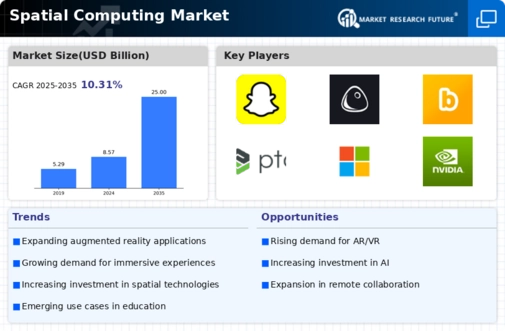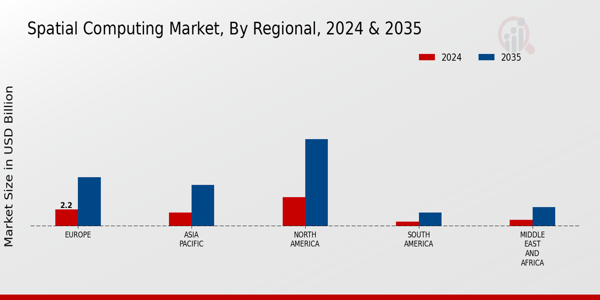Market Growth Charts
Technological Advancements
The Global Spatial Computing Market Industry is experiencing rapid growth driven by advancements in technologies such as augmented reality, virtual reality, and artificial intelligence. These technologies enhance user experiences by providing immersive environments for various applications, including gaming, education, and healthcare. For instance, the integration of AR in medical training allows practitioners to visualize complex procedures in real-time. As a result, the market is projected to reach 8.57 USD Billion in 2024, indicating a strong demand for innovative solutions that leverage spatial computing capabilities.
Rising Investment in Smart Cities
The Global Spatial Computing Market Industry is significantly influenced by rising investments in smart city initiatives. Governments and private sectors are increasingly funding projects that integrate spatial computing technologies to enhance urban living. These initiatives often involve the use of sensors, IoT devices, and spatial analytics to improve infrastructure, transportation, and public services. As cities evolve into smart environments, the demand for spatial computing solutions is expected to surge, contributing to the market's expansion and aligning with global sustainability goals.
Increased Adoption in Various Sectors
The Global Spatial Computing Market Industry is witnessing increased adoption across diverse sectors, including retail, real estate, and manufacturing. Companies are utilizing spatial computing to improve customer engagement, streamline operations, and enhance product visualization. For example, retailers are employing AR applications to allow customers to visualize products in their homes before making a purchase. This trend is likely to contribute to the market's growth, with projections indicating a rise to 25 USD Billion by 2035, reflecting the potential for spatial computing to transform traditional business practices.
Enhanced Data Visualization Capabilities
The Global Spatial Computing Market Industry benefits from enhanced data visualization capabilities that enable organizations to interpret complex datasets more effectively. Spatial computing tools allow for the representation of data in three-dimensional formats, making it easier to identify patterns and trends. For instance, urban planners utilize spatial computing to visualize demographic data and infrastructure layouts, leading to more informed decision-making. This capability is increasingly recognized as vital for strategic planning across various sectors, further driving the market's growth as organizations seek to leverage data for competitive advantage.
Growing Demand for Remote Collaboration Tools
The Global Spatial Computing Market Industry is fueled by the growing demand for remote collaboration tools, particularly in the wake of evolving work environments. Organizations are increasingly seeking solutions that facilitate virtual meetings and collaborative projects, enabling teams to interact in shared digital spaces. This trend is evident in industries such as architecture and engineering, where spatial computing tools allow for real-time design modifications and feedback. As remote work continues to be a prevalent model, the market is expected to expand significantly, with a projected CAGR of 10.22% from 2025 to 2035.


















Leave a Comment